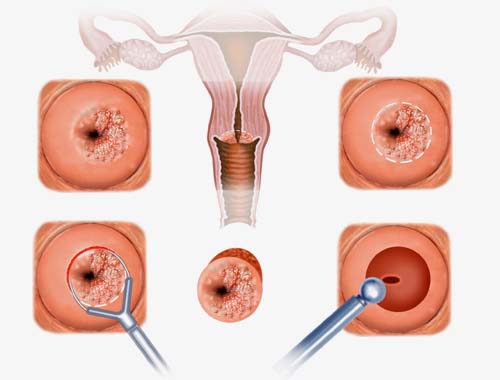LEEP (Loop Electrosurgical Excision Procedure)

Published: 18 Jun 2025
ICD9: 67.2 ICD10: 0UBC0ZZ ICD11: _
The Loop Electrosurgical Excision Procedure (LEEP), also known as Large Loop Excision of the Transformation Zone (LLETZ), is a procedure used to remove abnormal cells from the cervix.
Here's a breakdown:
What it is:
![]() Excision Procedure: It involves cutting away (excising) abnormal tissue.
Excision Procedure: It involves cutting away (excising) abnormal tissue.
![]() Loop Electrosurgical: Uses a thin, electrically heated wire loop as a scalpel to cut away the abnormal tissue. The electrical current also helps to seal the blood vessels, reducing bleeding.
Loop Electrosurgical: Uses a thin, electrically heated wire loop as a scalpel to cut away the abnormal tissue. The electrical current also helps to seal the blood vessels, reducing bleeding.
![]() Target: Cervix: The cervix is the lower part of the uterus that connects to the vagina.
Target: Cervix: The cervix is the lower part of the uterus that connects to the vagina.
![]() Transformation Zone: This is the area on the cervix where the cells change (transform). It's also the area where abnormal cells are most likely to develop.
Transformation Zone: This is the area on the cervix where the cells change (transform). It's also the area where abnormal cells are most likely to develop.
Why it's done:
![]() Abnormal Pap Smear Results: LEEP is often recommended after a Pap smear (cervical screening test) shows abnormal cells, such as precancerous changes (cervical dysplasia).
Abnormal Pap Smear Results: LEEP is often recommended after a Pap smear (cervical screening test) shows abnormal cells, such as precancerous changes (cervical dysplasia).
![]() Suspicious Cervical Appearance: A doctor might recommend LEEP if they see something unusual on the cervix during a pelvic exam.
Suspicious Cervical Appearance: A doctor might recommend LEEP if they see something unusual on the cervix during a pelvic exam.
![]() Confirmation and Treatment: It serves as both a diagnostic and treatment tool. The removed tissue is sent to a lab for examination to confirm the presence of abnormal cells, the type of abnormality, and whether all of the abnormal tissue was removed.
Confirmation and Treatment: It serves as both a diagnostic and treatment tool. The removed tissue is sent to a lab for examination to confirm the presence of abnormal cells, the type of abnormality, and whether all of the abnormal tissue was removed.
How it's done:
1. Preparation:![]()

![]() The patient lies on an examination table with their feet in stirrups, similar to a pelvic exam.
The patient lies on an examination table with their feet in stirrups, similar to a pelvic exam.![]()

![]() A speculum is inserted into the vagina to visualize the cervix.
A speculum is inserted into the vagina to visualize the cervix.![]()

![]() Local anesthesia is injected into the cervix to numb the area.
Local anesthesia is injected into the cervix to numb the area.
2. The Procedure:![]()

![]() The LEEP device (the thin wire loop) is inserted through the speculum and used to carefully cut away the abnormal tissue.
The LEEP device (the thin wire loop) is inserted through the speculum and used to carefully cut away the abnormal tissue.![]()

![]() The electrical current helps to control bleeding.
The electrical current helps to control bleeding.
3. After the Procedure:![]()

![]() A special paste may be applied to the cervix to help stop any residual bleeding.
A special paste may be applied to the cervix to help stop any residual bleeding.![]()

![]() The removed tissue is sent to a pathology lab for analysis.
The removed tissue is sent to a pathology lab for analysis.
Benefits:
![]() Effective Treatment: LEEP is highly effective at removing abnormal cervical cells.
Effective Treatment: LEEP is highly effective at removing abnormal cervical cells.
![]() Relatively Quick: The procedure usually takes about 10-20 minutes.
Relatively Quick: The procedure usually takes about 10-20 minutes.
![]() Outpatient Procedure: It's typically performed in a doctor's office or clinic and doesn't require a hospital stay.
Outpatient Procedure: It's typically performed in a doctor's office or clinic and doesn't require a hospital stay.
![]() Minimally Invasive: Compared to other surgical options, LEEP is less invasive.
Minimally Invasive: Compared to other surgical options, LEEP is less invasive.
Risks:
![]() Bleeding: Some bleeding or spotting is common after the procedure.
Bleeding: Some bleeding or spotting is common after the procedure.
![]() Infection: There's a small risk of infection.
Infection: There's a small risk of infection.
![]() Cervical Stenosis: Narrowing of the cervical opening (rare).
Cervical Stenosis: Narrowing of the cervical opening (rare).
![]() Preterm Labor/Delivery: In rare cases, LEEP can slightly increase the risk of preterm labor in future pregnancies.
Preterm Labor/Delivery: In rare cases, LEEP can slightly increase the risk of preterm labor in future pregnancies.
![]() Scarring: Scarring of the cervix.
Scarring: Scarring of the cervix.
![]() Pain: Mild cramping or discomfort after the procedure.
Pain: Mild cramping or discomfort after the procedure.
Important Considerations:
![]() Follow-up: Regular follow-up Pap smears are essential after a LEEP procedure to monitor for any recurrence of abnormal cells.
Follow-up: Regular follow-up Pap smears are essential after a LEEP procedure to monitor for any recurrence of abnormal cells.
![]() Communication with Your Doctor: It's crucial to discuss the risks and benefits of LEEP with your doctor and ask any questions you may have.
Communication with Your Doctor: It's crucial to discuss the risks and benefits of LEEP with your doctor and ask any questions you may have.
In summary, LEEP is a common and effective procedure for treating abnormal cervical cells. It's important to discuss your individual situation and risks with your healthcare provider to determine if LEEP is the right treatment option for you.